It’s Friday morning, and you’re ready to wrap up a successful week.
That is until you receive your latest employee survey results that deliver one loud message: Your employees feel like their ideas aren’t valued.
You’re surprised. Your colleagues are great. You feel like your ideas and opinions are respected by other members of the leadership team.
But now that you think about it, you have heard about some of the snarky comments people make on other teams.
How people feel anxious to speak up with their ideas or suggestions.
You remember someone saying they were afraid to rock the boat during a review meeting, so they just played it safe by asking the usual questions during the brainstorming session.
But what if these employees’ ideas could have triggered big innovative changes at your company?
What if their willingness to present something different encouraged others to contribute their ideas as well and initiate game-changing products?
Research shows that when employees feel comfortable asking questions, expressing ideas, or constructively criticizing their colleagues, their organizations are more innovative, creative, and adaptable.
When employees feel comfortable poking the status quo and they don’t fear negative consequences, they enjoy what’s known as psychological safety.
Developed by organizational behavioral scientist Amy Edmondson, psychological safety refers to “a shared belief held by members of a team that the team is safe for interpersonal risk taking.”
You can think of it as the difference between raising your hand with a question or forging ahead with a task that's unclear, because you’re afraid to be ridiculed.
It’s also the difference between sharing an undeveloped idea with your team, safe in the knowledge that they’ll consider it nonjudgmentally, or staying quiet and moving forward with the status quo, because you don’t want to be harshly criticized.
If you felt psychological safety, you’d be comfortable presenting bold ideas at your annual strategy meeting without weighing the ramifications. Less time would go into thinking about the optics and more time would go into debating new approaches with your team.
Why should you measure psychological safety?
It’s clear that psychological safety is important. Every organization wants more innovative, creative, and collaborative employees. So should you measure it?
Yes. Since psychological safety is correlated to such positive organizational attributes, it’s worth knowing how much of it your company possesses.
And if you plan to improve the amount of psychological safety in your organization, measuring it helps you know whether it’s increased or decreased within your organization.
Measuring psychological safety can also help you understand the cause of other important metrics such as retention. Employee retention is top of mind for many companies, especially as they navigate “The Great Resignation.”
Today’s employees stick with a job when it gives them a sense of purpose, when there’s no micromanagement, and when they can work effectively with their colleagues.
Essentially, they want to work on a great team.
Teams make complex things happen. They take individuals with their own skills, experiences, and resources and weld them into a tool directed towards a specific goal.
But these makeshift tools aren’t always well constructed. Some teams become incredible forces for change and innovation while others spend so much time arguing internally – or fail to speak to each other at all – that they struggle with the task at hand.
As the amount of collaborative work employees do skyrockets, it’s more important than ever for companies to build superstar teams.
This was the reason for Google’s Project Aristotle, a research project that brought together organizational psychologists, statisticians, engineers, and sociologists to figure out what made the perfect team. They analyzed hundreds of Google teams to figure out why some were more successful than others.
After two years of research, they realized that common shortcuts, like only putting introverts with introverts, weren’t any guarantee of team success.
Instead, they had five key characteristics: dependability, structure and clarity, meaning, impact, and, of course, psychological safety.
You can measure the amount of psychological safety through pulse surveys distributed to different teams.
Psychological safety survey questions to include in your next survey:
- I can make mistakes without fear that my coworkers will hold it against me.
- My co-workers welcome opinions different from their own.
- I feel safe to take a risk on this team.
- My direct manager values my ideas.
- People keep each other informed about work-related issues within the team.
- Members of this team are able to bring up problems and tough issues.
- People on this team never reject others for being different.
- It is easy to ask other members of this team for help.
- Working with members of this team, my unique skills and talents are valued and utilized.
- No one on this team would deliberately act in a way that undermines my efforts
Distribute the following statements to your employees as part of your next pulse survey. Ask them to rank their level of agreement with each statement, and use their responses as your new benchmark for psychological safety in your workplace.
I can make mistakes without fear that my coworkers will hold it against me.
Cautiousness is not a bad trait. Companies want their employees to be mindful when engaging with customers or executing processes in order to avoid costly mistakes. But in some companies, this cautiousness is used in unproductive ways.
Being overly cautious while managing a customers’ sensitive data is prudent and responsible.
Being cautious about making suggestions during a brainstorming session or asking questions when assigned a new task is not.
The difference between these two examples is how “fear” or “cautiousness” supports the primary goal.
In the first example, the primary goal is processing a customer’s transaction without compromising their financial data. So a little bit of fear has a lot of upsides.
In the other examples, the goal is to think big in order to be innovative and to solve problems, or to receive clarification for a project.
In these cases, fear doesn’t support the goal. Fear prevents a person from speaking up with a question or an idea, leading to unexplored options or costly mistakes.
This kind of fear causes people to fall into the “All or Nothing” thinking trap. This thinking trap prevents people from moving forward unless they’ve reduced all uncertainty or feel absolutely confident or there’s no anxiety about a course of action.
It’s a shame, too, because one of the best ways to innovate is to build on ideas, and one of the most effective ways to avoid expensive re-work is to provide clear, upfront expectations.
For this to happen, employees must feel comfortable sharing their half-formed ideas or “silly” questions.
And for that to happen, employees have to feel comfortable making mistakes in front of their colleagues.
My co-workers welcome opinions different from their own.
Homogenous teams can be efficient. People who think similarly or have the same training and professional experience tend to view situations the same way and reach consensus more quickly.
But there’s a downside to this efficiency. When a group of people share the same point of view, they also share the same blindspots.
On the other hand, diversity of thought allows teams to spot risks and even opportunities. The trade-off is more debate and slower decision-making, but in some organizations, such as organizations focused on growth and innovation, this trade-off is worth it.
Of course, creating an environment with diversity of thought is difficult. Even if employees have differing perspectives or opinions, they may not feel comfortable speaking up and standing out.
There are typically two explanations for this: the personality perspective and the situational perspective.
The personality perspective attributes this unwillingness to speak up to an employee’s personality. They’re not the type to speak up, so they won’t, and companies might “correct” for this by hiring more outgoing and outspoken employees.
The situational perspective attributes “hesitancy to speak up” to the work environment. Employees don’t speak up because they feel like they’ll pay a high social cost for their input. Translation: They don’t feel enough psychological safety.
Asking your employees whether their co-workers welcome diversity of thought is a useful way to gauge how much psychological safety exists within your teams and your company at large.
I feel safe to take a risk on this team
You might have high levels of psychological safety organization-wide, but that doesn’t mean it’s evenly distributed across your teams.
Colleagues need to feel comfortable taking calculated risks within their teams. People who take calculated risks weigh the pros and cons of moving forward with a task or project and learn how to flourish with incomplete information.
This kind of savviness relies on your confidence within a team.
Teams that cultivate psychological safety encourage their employees to take risks and as a result, these employees become better at spotting opportunities.
Keep in mind that psychological safety isn’t about giving employees a cushion to land on when they are reckless. Instead, it’s about giving them an environment in which to grow, and growth can sometimes be painful. Great managers encourage their employees to take calculated risks by:
- Sharing strategic objectives: When employees understand a team or an organization’s larger objectives, they have the context to make better decisions and conduct more effective cost-benefit analyses.
- Improving processes: Creating streamlined processes and failsafes encourages employees to be creative and innovative, because they know the mission-critical tasks have a clear operating procedure. For example, a developer can get creative on a project knowing that there are backup files safely stored elsewhere.
- Defining what constitutes a smart risk: Managers gain experience on where they can be bold and where they need to exercise caution. It’s worth sharing these insights with employees, so they can practice.
- Leading by example: Telling employees that they can disagree isn’t enough, especially if you haven’t built enough trust or credibility. During brainstorming sessions, consider sparking discussion by asking your team to think about what they would do if you completely eliminated a specific process or took a controversial approach to a project.
- Rewarding people who take risks: If someone tries something new and it doesn’t work out, recognize their effort and tie incentives to that risk taking, especially if it was a well-calculated risk. This gives fellow team members an example of the kind of risk taking you want to see, and also encourages them to take risks themselves.
My direct manager values my ideas.
The less receptive managers are to employees’ ideas, the less likely they are to share them, and the more likely your organization is to continue doing the same things over and over again. So ask your employees whether their direct managers value their ideas.
In some cases, managers set aside employees’ ideas because they are not aligned with the work the team is meant to do, there’s no budget for the idea, or the idea just isn’t particularly good. But there are ways to make employees’ ideas feel valued even when they can’t always be executed. And it’s worth the time, because it might encourage employees with great ideas to step forward if they see how respectfully those with underdeveloped ideas are treated.
How can you show your employees that you value their ideas, even if you can’t follow through on them?
- Make time: During your one-on-one meetings, give your team members time to chat about any ideas they’ve been thinking about.
- Ask constructive questions: Help your employees flesh out their ideas without demoralizing them. Ask them how they would execute this idea, how much it would cost, and how it would help the team meet its larger objectives, but do so in a way that’s constructive rather than shooting down the thought.
- Coach them: Help your team members come up with well thought out ideas. For example, if an idea’s promising, you might want to encourage that employee to write a business case to justify it and to get time and funding.
People keep each other informed about work-related issues within the team.
Think about the last time you worked within an organization or a team with minimal psychological safety. You probably felt anxious sharing any issues with your colleagues.
If there was a hiccup, you kept it quiet in the hope that you could smooth things over later.
If you could, great. If you couldn’t, you wound up with a bigger problem than you would’ve had if you’d asked for help.
Teams with great communication, especially about work-related issues, tend to have a higher degree of psychological safety. They know that they can reach out for help, and they understand that others will let them know if there’s a problem.
You can always improve the quality of communication within your team by:
- Having an open door policy: Make it clear to your employees that they can always stop by to speak to you or send you an invite for a 15-minute call to discuss an issue.
- Providing constructive feedback: Be mindful of how you deliver feedback. If there’s an issue, focus on problem solving instead of assigning blame.
- Organizing team building activities: Schedule time for your team to have fun instead of just work. This gives your team an opportunity to build relationships and trust in a way that isn’t exclusively tied to work.
- Conducting communications training: Communication is a skill and it can be learned. Consider investing in some communication training or workshops for your teams. Learning about things like the communication process or nonviolent communication can help.
Members of this team are able to bring up problems and tough issues.
Some of the most common problems faced by teams include difficulty managing change, unclear work expectations, and an unfair division of labor.
When there’s limited psychological safety, it’s easy for these issues to get brushed under the rug because team members don’t feel comfortable speaking up.
The result is that these relatively minor issues fester until they become an infectious problem that destroys the entire organism. Employees working on teams with a high amount of psychological safety are able to speak up when something isn’t right.
If something goes wrong because a team member didn’t do their part or provide a crucial piece of information, they can respectfully air their grievance knowing the other will listen with empathy and take accountability.
Working through tough interpersonal issues allows teams to work even better together when managing trickier business problems. Your team can collaborate more effectively.
A few ways you can encourage problem solving on your team include:
- Conducting training on different problem solving strategies and empathetic listening
- Getting out of your team’s way and trusting them to find a solution to their problems while expressing that you’re available if they need guidance
- Leading by example by being respectful and constructive in your interactions with employees
People on this team never reject others for being different.
An inclusive team environment is a strong indicator of high psychological safety.
When you feel accepted and respected by your colleagues, you feel more comfortable opening up and relating to them, which leads to trust.
On the other hand, if you feel like you’re routinely “othered” you’re less likely to want to open up and share what’s known as a “status-confirming disclosure.”
A status-confirming disclosure is a piece of personal information that you’re worried will highlight your difference and lead your colleagues to make stereotypes about you.
Consider this example highlighted in Harvard Business Review in which a black executive felt uncomfortable talking about the concert she saw over the weekend because it was a gospel artist that she worried her colleagues wouldn’t be familiar with.
Her concern was that they would view her as “different” from them and change their perception of her, even if unconsciously.
This is one of the key differentiators between a diverse organization and an inclusive organization.
A diverse organization has people from different backgrounds.
An inclusive organization ensures all of these individuals feel like they can thrive and work without hiding elements of themselves.
It is easy to ask other members of this team for help.
Often, employees don’t want to ask for help because they’re worried they’ll be a nuisance or they’ll reveal their inadequacy.
But asking for help can often save teams more time by avoiding expensive re-work. At the same time, these requests for help may predominantly fall on one team member who winds up overwhelmed by the responsibility and even resentful of the distraction from their work.
Create an environment where people feel comfortable asking for help.
You can balance this with the demands of a busy workplace by getting into the habit of documenting all processes so that employees have self-serve knowledge hubs available to them.
This way, when someone asks for help, their colleagues can politely direct them to the right resource. You can consider:
- Recording all meetings for a project so that any new employees can quickly get up to speed
- Creating systems for frequently repeated processes and documenting them so that employees can refer to easy-to-use manuals
- Creating dedicated experts within the team on specific areas (e.g., invoicing) so people know who to ask for help, they can get useful information, and the task of “helping” is split evenly among the team
Working with members of this team, my unique skills and talents are valued and utilized.
We do our best work when we’re working on things we’re good at.
But managers often forget this when assigning work.
It goes without saying that there will be times when you have to do things you don’t feel like doing.
But generally speaking, it’s a good idea for managers to allocate tasks to their team members based on what employees are best at. This way, employers can tap into their employees’ full potential.
One report from SHRM finds that 85% of employees don’t feel they can live up to their full potential at work because their skills aren’t properly utilized.
Imagine if they had an opportunity to use them. Through regular performance management meetings, managers can get a better idea of what their employees have to offer and use these gifts accordingly.
Understanding where your employees’ strengths lie can also help you undertake more effective upskilling initiatives. If you know what your employees enjoy and you know where your company’s skills gaps are, you can put employees on an appropriate learning path, giving them a chance to feel more engaged through professional development.
No one on this team would deliberately act in a way that undermines my efforts
Many employees spend more time with their “work family” than their actual family.
It makes sense then that having a good relationship with your colleagues would create a more positive and productive workplace.
Not everyone has a great “work family.” In fact, some employees have to deal with colleagues that struggle to cooperate, collaborate, and communicate.
If you rank poorly on this question, you have an opportunity to enhance your workplace culture by working team-building initiatives into your people and culture strategy.
The benefits of a robust employee survey platform
A robust employee survey platform such as Sparkbay can help leaders understand obstacles and opportunities and focus their efforts where it matters. It can also track engagement and satisfaction over time to identify which actions are working and which aren't.
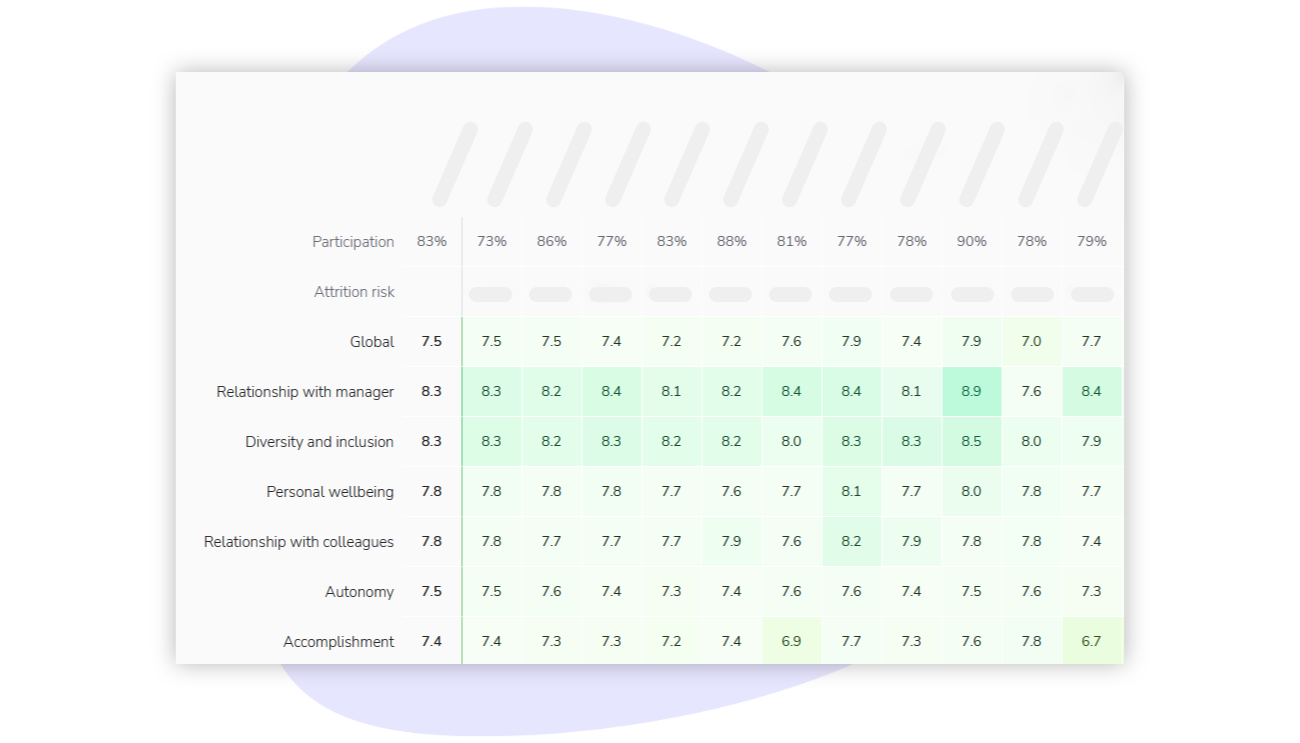
Explore employee data any way you want
It is important to be able to segment data based on demographics such as tenure and role. Sparkbay allows leaders to interrogate their data in any way they want to uncover deeper insights about their people.
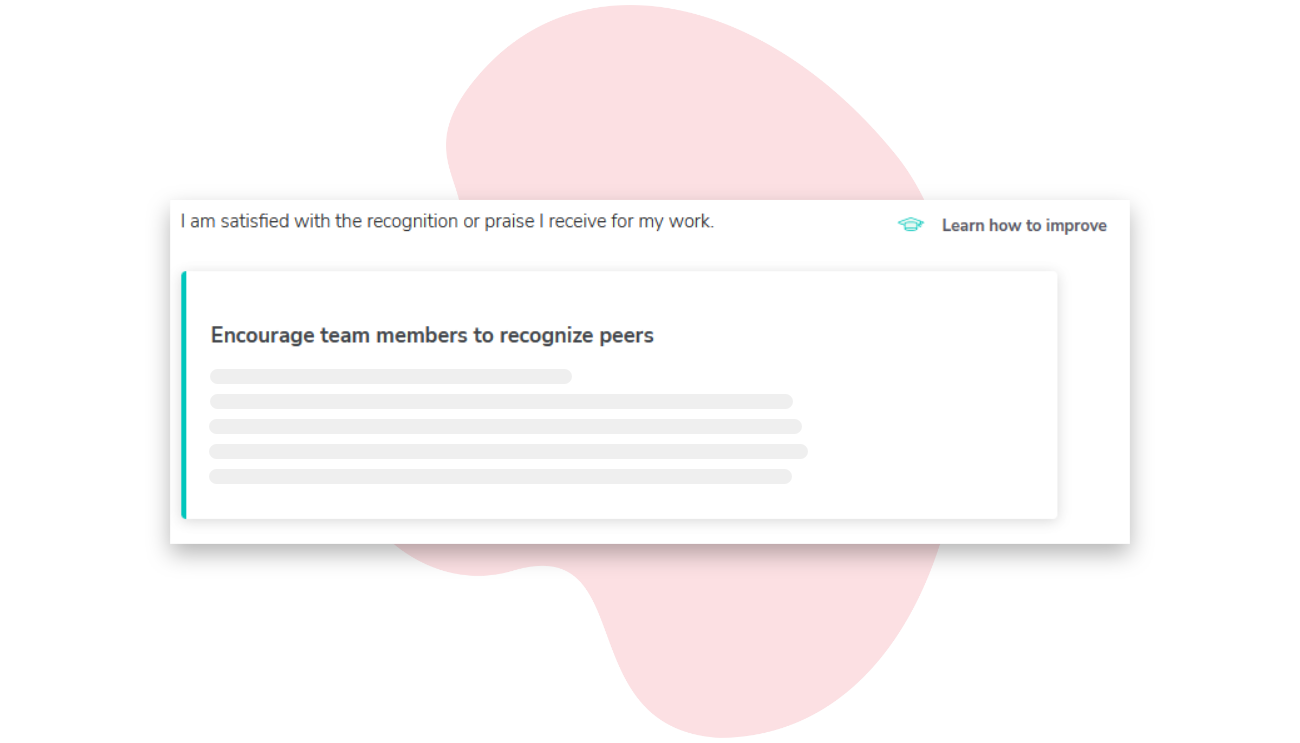
Empowers action
Surveying employees serves no purpose if leaders do not take advantage of the opportunities they discover. With Sparkbay's automated coaching, managers can act on easy-to-implement strategies. These tools drive action to ensure you meet your employee-centric objectives.
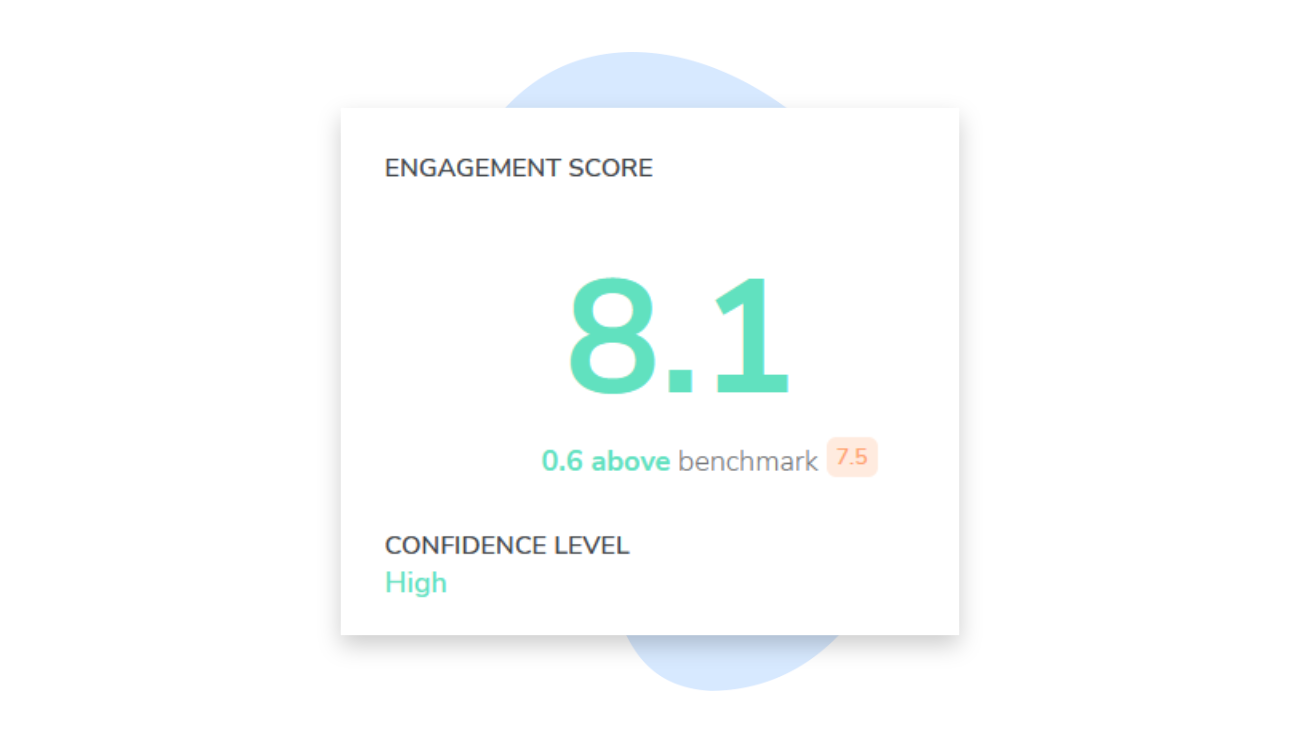
Provides robust benchmarks
Leaders need to compare their survey results with industry benchmarks to understand how they are doing. Using the right survey platform, you can compare your survey data with others in your industry, similar-sized companies, and top employers.
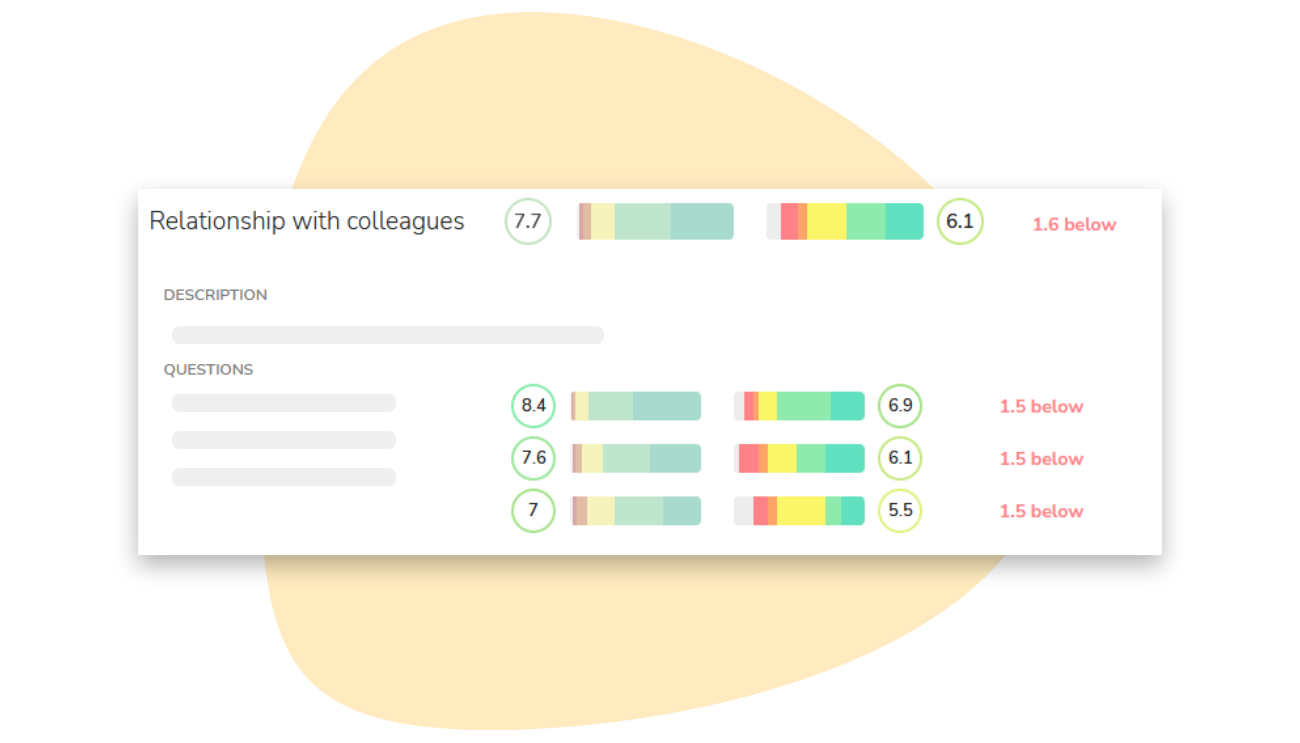
Equips managers with dashboards to visualize their results
Manager dashboards help managers visualize their survey results all in one place. With these dashboards, managers can easily track employee experience trends, and identify strengths and opportunities.
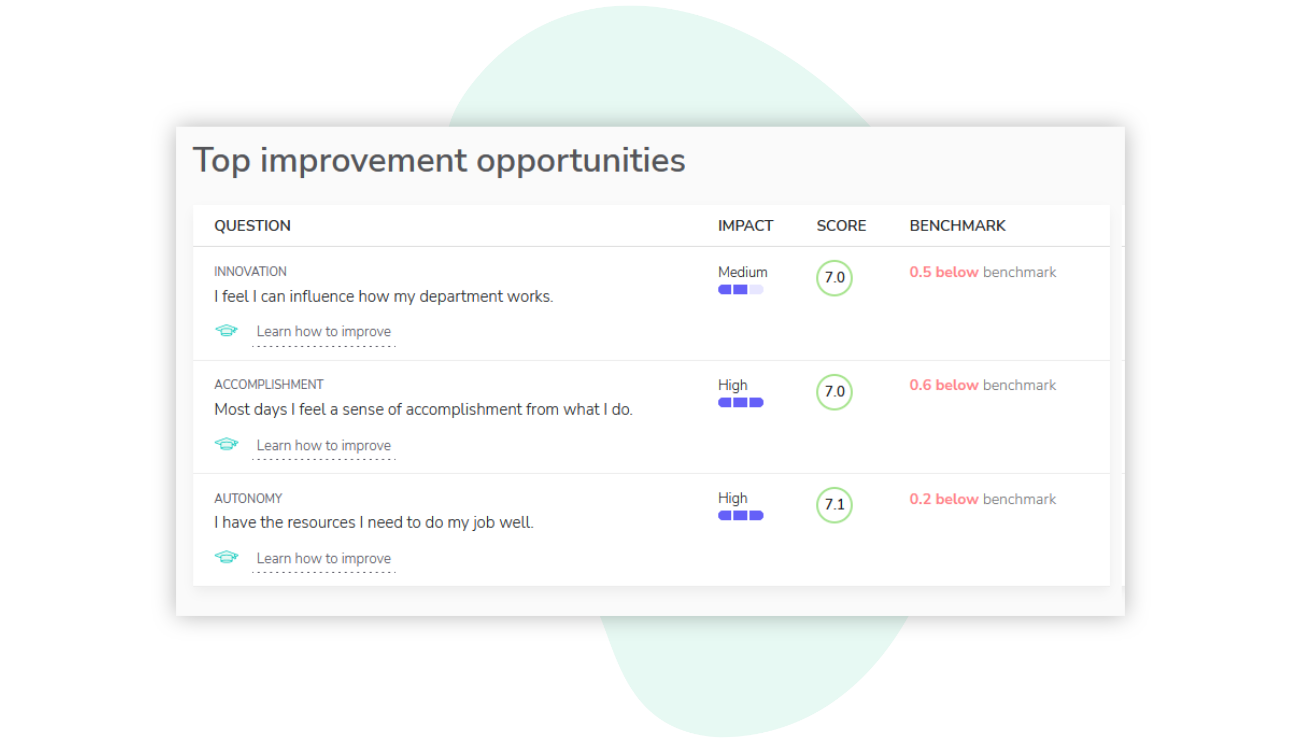
Provides a seamless user experience
You don't want your managers to waste valuable time on a clunky, hard-to-use platform. We designed Sparkbay with simplicity in mind. Your managers will master our intuitive dashboards in no time.

Gain access to real-time results
Taking action is the most significant part of your survey strategy. That’s why Sparkbay's real-time results let you expedite your process and propel insights into action.
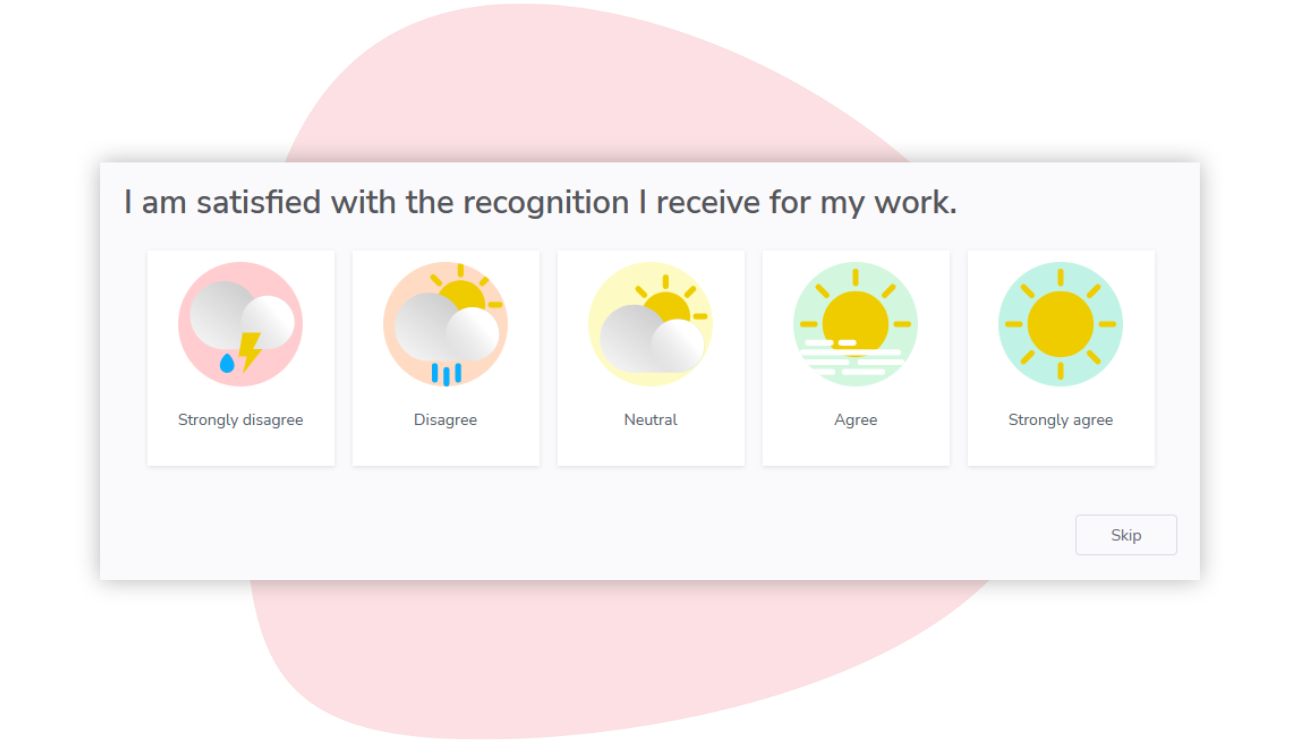
Using the right survey software
By leveraging the right survey software, you can quickly understand where your employees stand when it comes to psychological safety in the workplace. Sparkbay’s employee survey tool makes it easy for organizations to distribute pulse surveys and track data while keeping all employees’ responses anonymous.
Get in touch with a member of our team to learn how Sparkbay’s survey platform can help you build a better workplace through our employee surveys.
If you're interested in learning how Sparkbay can help you survey your employees, you can click here for a demo.

